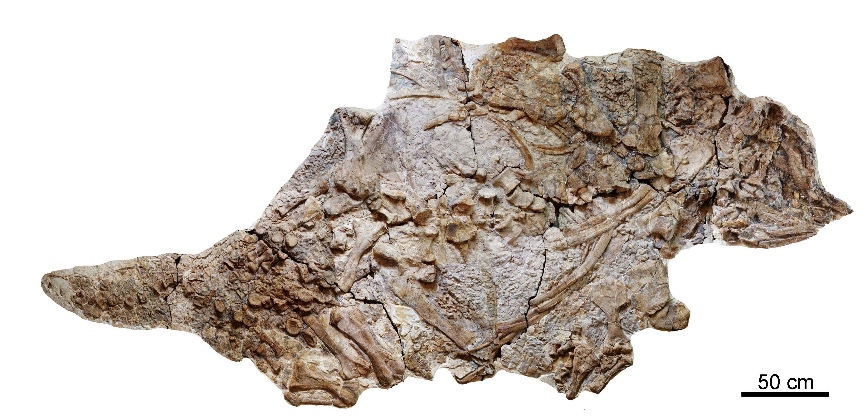Giant Armored Dinosaur Unearthed in China

Farmers in China have unearthed the nearly complete skeleton of a juvenile armored dinosaur that may be one of the largest ankylosaurs. The finding suggests that this group of beasts grew to be big early in their evolutionary history, researchers say.
The new finding is in line with the growth trend seen among dinosaurs beginning in the Cretaceous Period, the heyday of the dinosaurs, when they reached their greatest diversity, the researchers said.
Ankylosaurs were four-legged plant-eating dinosaurs with heavy armor covering much of their massive bodies. These living tanks were also sometimes armed with fearsome bony clubs at the ends of their tails. Their remains have been found on all continents except Africa.
The new ankylosaur is named Chuanqilong chaoyangensis. Chuanqilong is derived from Chinese words meaning "legendary dragon," and chaoyangensis refers to the area in which it was found. The nearly complete skeleton of the ancient reptile was unearthed by local farmers from a quarry in Liaoning province in northeastern China, which has yielded a trove of discoveries of feathered dinosaurs over the last decade. [Images: A Trove of Feathered Dinosaurs]
This ankylosaur lived about 110 million years ago during the Cretaceous Period, which started about 145 million years ago and ended about 67 million years ago with the mass extinction that killed off all dinosaurs except the birds. This fossil is the most complete ankylosaur from the Cretaceous Period found so far in Liaoning, said lead study author Fenglu Han, a vertebrate paleontologist at China University of Geosciences in Wuhan and the Key Laboratory of Vertebrate Evolution and Human Origins of the Chinese Academy of Sciences in Beijing.
C. chaoyangensisis the fourth ankylosaur species known from the Cretaceous of Liaoning, thus suggesting that this area was once home to a very diverse range of these dinosaurs.
This fossil specimen was about 14.7 feet (4.5 meters) long, which makes it only moderate in size compared with other known ankylosaurs, the researchers said. However, they added that this specimen was not fully grown, suggesting that adult versions of this dinosaur might have been among the largest ankylosaurs, such as Cedarpelta, which could grow to be 26 feet (8 m) long, Han said.
Sign up for the Live Science daily newsletter now
Get the world’s most fascinating discoveries delivered straight to your inbox.
The newly discovered fossil does not have a tail club nor other, more evolved features seen in other ankylosaurs, the researchers who examined the bones said, thus suggesting Chuanqilong lies near the root of the ankylosaur family tree.
These findings suggest that ankylosaurs may have evolved to be large early in their evolutionary history, the researchers said.
"Many dinosaurs got to large sizes in the Early and Late Cretaceous," Han told Live Science. "This might be related to environmental changes — they could get more food. Additionally, large body sizes could help them defend against predators."
The scientists detailed their findings online Aug. 13 in the journal PLOS ONE.
Follow Live Science @livescience, Facebook & Google+. Original article on Live Science.











